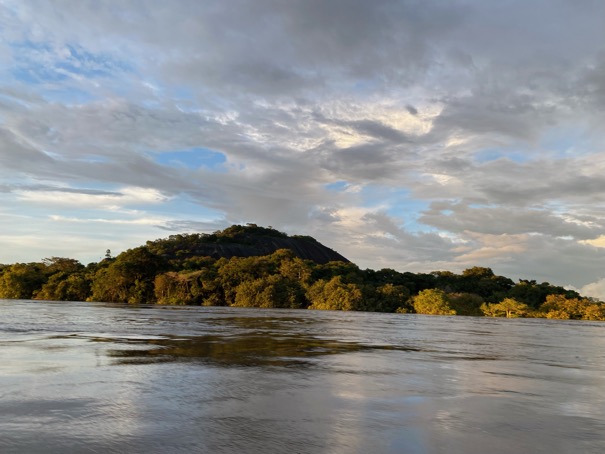Basin of the Orinoco River and Images of Bogota 🇨🇴

The Orinoco River, on the border between Colombia and Venezuela, July 2022
At the end of July 2022, I traveled to Colombia for work, beginning with meetings in Bogotá. My time in the capital involved discussions with colleagues from the ECHO office, the Colombian Red Cross, Civil Protection Authorities, and government representatives, as we coordinated on humanitarian response efforts across the country.
Exploring Bogotá – The Heart of Colombia
While in Bogotá, I also found time to explore the city during my free afternoons. Bogotá has a unique energy—a blend of historical richness and modern vibrancy. The city sits high in the Andes, with cool, crisp air and a mix of colonial architecture and contemporary urban design.
• I visited La Candelaria, the historic district known for its colourful colonial buildings, cobbled streets, and the Botero Museum, filled with the works of the famous Colombian artist Fernando Botero.
• Monserrate, a mountain peak towering over Bogotá, offers panoramic views of the city, where I could appreciate the contrast between the modern urban sprawl and the Andean landscape that surrounds it.
• The Gold Museum was another highlight, where I learned about Colombia’s rich pre-Columbian history and the ancient cultures that once thrived in the region.
The vibrancy of Bogotá—the street markets, the art scene, and the lively cafés—made it clear why it is considered the cultural and political capital of Colombia.
Challenges in Eastern Colombia – The Struggles of Vulnerable Communities
After Bogotá, I headed to the eastern region of Colombia to visit various humanitarian and disaster preparedness projects. The eastern provinces, such as Vaupés, Guaviare, and Vichada, face some of the most acute challenges in Colombia, compounded by the region’s remoteness, limited infrastructure, and large numbers of migrants and displaced communities.
• Indigenous Communities: In the eastern region, indigenous communities are disproportionately affected by climate change, especially as they rely on agriculture and natural resources for their livelihoods. These communities face increased risks from flooding, droughts, and landslides, exacerbated by the lack of disaster preparedness infrastructure.
• Migrant Crisis: The migration crisis from Venezuela has placed significant strain on local resources. As more Venezuelans cross into Colombia, especially into border towns like Puerto Carreño, they often face severe overcrowding in temporary shelters and lack of basic services like healthcare, food, and clean water. Many migrants are also left without legal status, making it difficult for them to access government aid.
• Conflict and Security: The region is also affected by ongoing conflict with armed groups, making access to some areas difficult and dangerous. The presence of illegal armed groups and drug trafficking in the area further complicates the provision of humanitarian aid.
• Lack of Infrastructure: The remoteness of the eastern region means that many communities are isolated, with poor road infrastructure and limited access to essential services. Transporting aid to these communities can be a challenge, especially during the rainy season when rivers swell and roads become impassable.
Humanitarian Efforts and Response
While the challenges are significant, it was inspiring to see the efforts of the local humanitarian community working in the eastern region. Organisations like Caritas and local Colombian NGOs have been working tirelessly to provide emergency relief, including food aid, healthcare, and shelter for migrants and displaced people.
I also had the chance to witness firsthand the resilience of the local communities, who, despite the harsh conditions, continue to support one another. From indigenous leaders advocating for better resources to volunteers helping migrants, there was a strong spirit of solidarity that I found encouraging.
Exploring the Eastern Region
• Puerto Carreño: This border town on the Orinoco River is a hub for humanitarian activities. We traveled by boat to Casuarito, a remote area where Venezuelan migrants had set up makeshift communities. The sight of these settlements was a heartbreaking reminder of the dire conditions migrants face.
• Fernando Girón Tovar: A small community where I visited families in temporary shelters. Many had fled violence and extreme poverty in Venezuela and were now trying to rebuild their lives in Colombia.
• Casuarito: Reaching Casuarito by boat allowed me to see the lush, isolated beauty of the region, but it also highlighted the challenges of delivering aid in such remote locations.
A Memorable Trip
Despite the difficult conditions and ongoing challenges in the east, I truly enjoyed my time in eastern Colombia. The trip allowed me to connect with the communities and see the impact of humanitarian aid up close. At the same time, it was also deeply rewarding to be part of efforts that are helping vulnerable populations rebuild their lives.
This experience reinforced my belief in the importance of humanitarian response, especially in areas left behind by mainstream development. It was a reminder of how essential it is to continue supporting those who need it the most, especially in the face of climate change, migration, and conflict.
Click here to access the album.
